Welcome to our comprehensive guide to the Blue Birds of Virginia! From the majestic Blue Jay to the charming Eastern Bluebird, Virginia is home to a variety of blue-hued birds that will captivate your heart and fill your bird-watching diary with enchanting encounters. The Virginia Bluebird Society actively promotes the installation of nest boxes during the breeding season, as they play a crucial role in conservation efforts.
Our guide not only offers a detailed account of the 12 blue birds found in Virginia, including the vibrant blue jays with their blue-gray and sky-blue plumage but also gifts you with a free photo guide, making it easier for you to identify and document these beautiful creatures in their natural habitats. Additionally, we provide tips on setting up your bird feeder to attract these stunning blue birds. Get ready to embark on a journey through the skies of Virginia, where a tapestry of blue awaits your discovery!
Blue Birds Found In Virginia
The diversity of habitats found in Virginia, from the Atlantic coastline and the Chesapeake Bay to the Blue Ridge Mountains and extensive hardwood forests, contributes to the wide variety of bird species found in the state. These different landscapes offer an array of nesting and feeding opportunities for birds, making Virginia a haven for both resident and migratory bird species. Additionally, the state’s location along the Atlantic Flyway, a major migratory route, attracts a plethora of birds, enhancing its biodiversity and making it a prime location for bird watching.
Indigo Bunting


| Feature | Measurement |
|---|---|
| Scientific Name | Passerina cyanea |
| Length | 4.5–5.1 in |
| Wingspan | 7.1–9.1 in |
| Weight | 11.2–21.4 g |
The Indigo Bunting is a strikingly vibrant songbird, often hailed for its brilliant blue plumage and melodic song that graces woodlands and meadows during the warmer months.
Appearance: Males are renowned for their bright indigo blue feathers, which can appear darker in certain lights. Females and juveniles, on the other hand, are brown with subtle hints of blue on their wings and tail. The species lacks the vibrant streaking or spotting commonly found in many other songbirds.
Diet: Indigo Buntings primarily subsist on seeds, especially during non-breeding seasons. During the breeding season, they also consume a variety of insects such as beetles, caterpillars, and spiders, providing essential protein for their growing chicks.
Reproduction: Indigo Buntings build their nests close to the ground in shrubs or low tree branches. These nests, crafted meticulously with grasses and other plant materials, cradle clutches of typically 3 to 4 eggs. After hatching, the young are fed by both parents until they’re ready to fledge.
Eastern Bluebird
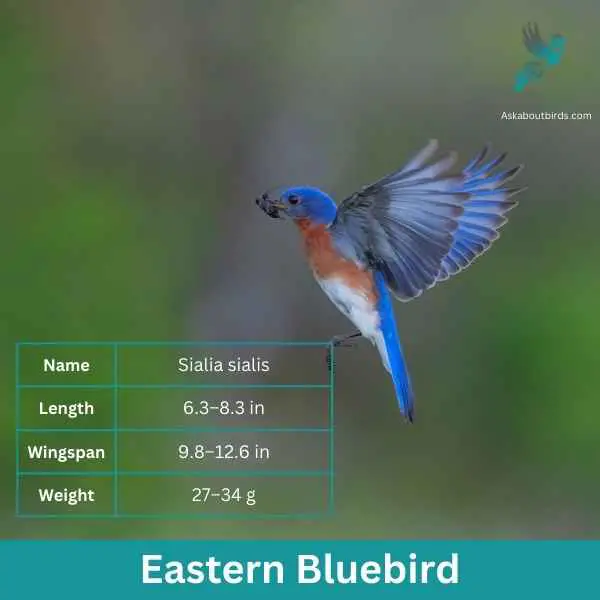
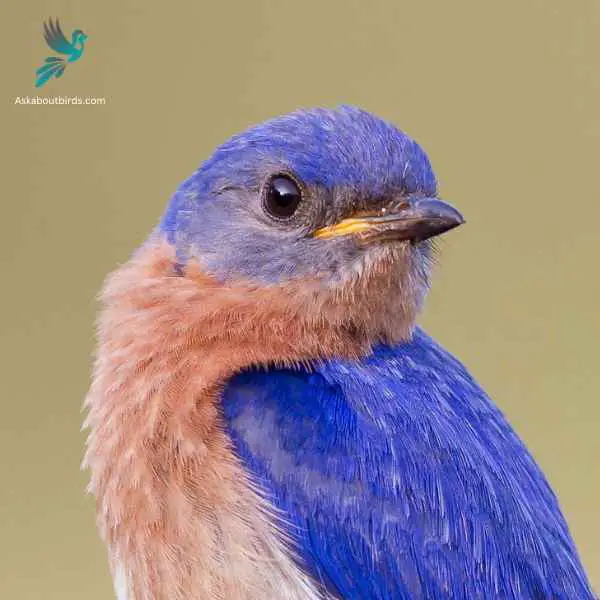
| Feature | Measurement |
|---|---|
| Scientific Name | Sialia sialis |
| Length | 6.3–8.3 in |
| Wingspan | 9.8–12.6 in |
| Weight | 27–34 g |
The Eastern Bluebird (Sialia sialis) is a small thrush found in open woodlands, farmlands, and orchards, and is recognized for its vibrant blue and red coloration. Male Eastern Bluebirds are dazzling with bright blue upperparts and a rusty or brick-red throat and breast, while females, though less colorful, still offer a similar pattern. The bird is native to North America and is commonly seen east of the Rockies, from Canada to the Gulf States and southeastern Arizona to Nicaragua.
Eastern Bluebirds feed on insects, wild fruit and berries. They have a gentle nature and are often seen perched alone or in small groups in the open, scanning the ground for prey. They are cavity nesters and will use old woodpecker holes or birdhouses if they are the right size.
Cliff Swallow
Scientific Name: Petrochelidon pyrrhonota
Length: 5-6 in (13-15 cm)
Wingspan: 11-12 in (28-30 cm)
Weight: 0.7-1 oz (20-28 g)
The Cliff Swallow is a small, agile bird known for its characteristic mud nests, social behavior, and long-distance migrations.
Appearance: Cliff Swallows have a distinctive appearance with a dark blue back, a cream-colored forehead, an orange-brown rump, and a buffy or whitish underbelly. They also have a square or slightly notched tail.
Diet: The diet of Cliff Swallows primarily consists of flying insects, including flies, beetles, and wasps, which they catch in the air while flying.
Reproduction: Cliff Swallows are known for building gourd-shaped mud nests, often in colonies on vertical cliff faces, bridges, or buildings. The female typically lays a clutch of 3 to 6 white eggs. Both parents participate in incubating the eggs and feeding the chicks.
Black-throated Blue Warbler
Scientific Name: Setophaga caerulescens
Length: 4.7-5.5 in (12-14 cm)
Wingspan: 7.9-8.7 in (20-22 cm)
Weight: 0.3-0.5 oz (8-15 g)
The Black-throated Blue Warbler is a small songbird known for its strikingly different male and female plumages and melodious song.
Appearance: Male Black-throated Blue Warblers have a deep blue upperpart, a black throat and sides, and a white belly. Females, on the other hand, are olive-brown above and pale yellow below with a faint white eyering and wing bars.
Diet: The diet of Black-throated Blue Warblers primarily consists of insects and spiders, although they also consume fruits and berries, particularly during the non-breeding season.
Reproduction: Black-throated Blue Warblers typically nest in dense shrubbery or low in trees. The female builds the nest and lays a clutch of 3 to 5 white eggs, marked with brown. The female incubates the eggs and takes the lead in feeding the chicks, although the male may assist in feeding the chicks as well.
Purple Martin
Scientific Name: Progne subis
Length: 7.5-9.1 in (19-23 cm)
Wingspan: 15.3-16.1 in (39-41 cm)
Weight: 1.9-2.3 oz (55-65 g)
The Purple Martin is a popular and widely recognized bird species, known for its acrobatic flight and social behavior.
Appearance: Purple Martins have a dark, glossy purple-blue plumage. Males are almost entirely dark purple while females and young birds have a lighter, greyish belly and throat.
Diet: The diet of Purple Martins primarily consists of flying insects such as beetles, flies, dragonflies, and moths. They catch their prey in mid-air while flying.
Reproduction: Purple Martins nest in colonies, often using artificial nest boxes provided by humans. The female typically lays a clutch of 4 to 6 white eggs, and both parents participate in incubating the eggs and feeding the chicks.
Blue Jay

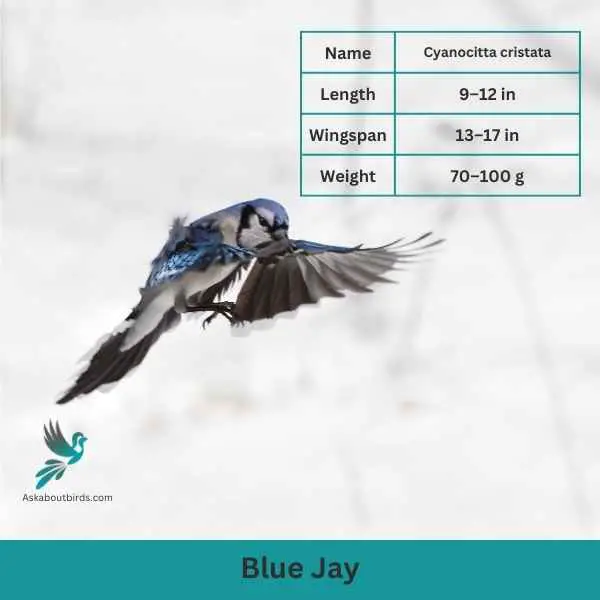
| Feature | Measurement |
|---|---|
| Scientific Name | Cyanocitta cristata |
| Length | 9–12 in |
| Wingspan | 13–17 in |
| Weight | 70–100 g |
The Blue Jay is a vibrant and easily recognized bird, known for its intelligence, distinctive calls, and bold behavior, commonly found throughout the eastern and central United States.
Appearance: The Blue Jay sports a striking blue upper body with white and black markings. Its face has a pronounced white patch with a black necklace that runs across the throat and around the head. The bird also features a pronounced blue crest, which can be raised or lowered, and its wings and tail are brightly colored with black bars and white tips.
Diet: Blue Jays are omnivores. Their diet consists primarily of seeds, nuts, especially acorns, fruits, and small insects. They’ve also been known to eat eggs or nestlings of other birds occasionally. Blue Jays often store food items in caches to eat later.
Reproduction: Blue Jays are monogamous birds that form long-lasting pair bonds. They typically build their nests in trees or large shrubs, constructing them from twigs, grass, and sometimes using mud as a binder. The female lays a clutch of 3 to 6 eggs, which are pale blue or sometimes white with brown speckles.
Indigo Bunting


| Feature | Measurement |
|---|---|
| Scientific Name | Passerina cyanea |
| Length | 4.5–5.1 in |
| Wingspan | 7.1–9.1 in |
| Weight | 11.2–21.4 g |
The Indigo Bunting is a strikingly vibrant songbird, often hailed for its brilliant blue plumage and melodic song that graces woodlands and meadows during the warmer months.
Appearance: Males are renowned for their bright indigo blue feathers, which can appear darker in certain lights. Females and juveniles, on the other hand, are brown with subtle hints of blue on their wings and tail. The species lacks the vibrant streaking or spotting commonly found in many other songbirds.
Diet: Indigo Buntings primarily subsist on seeds, especially during non-breeding seasons. During the breeding season, they also consume a variety of insects such as beetles, caterpillars, and spiders, providing essential protein for their growing chicks.
Reproduction: Indigo Buntings build their nests close to the ground in shrubs or low tree branches. These nests, crafted meticulously with grasses and other plant materials, cradle clutches of typically 3 to 4 eggs. After hatching, the young are fed by both parents until they’re ready to fledge.
Tree Swallow
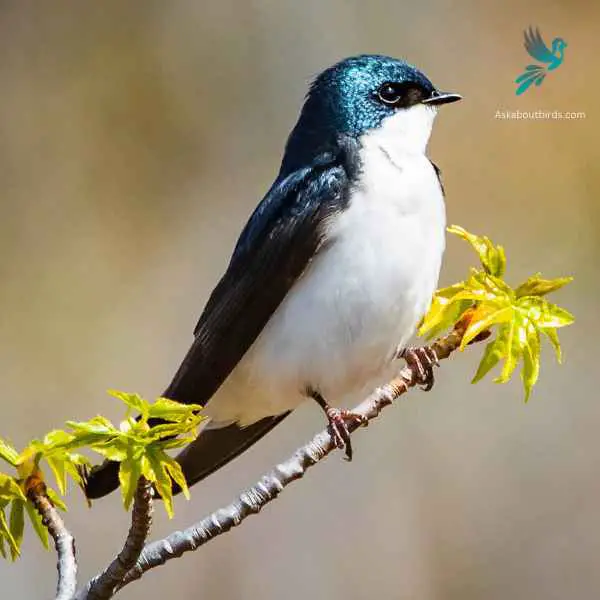
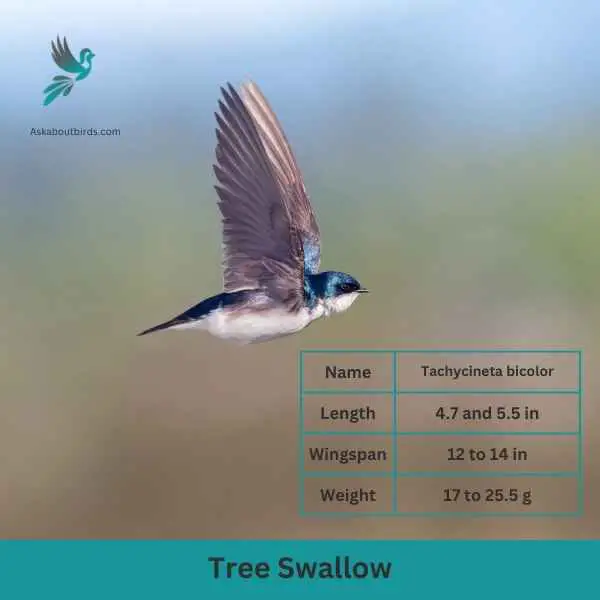
| Feature | Measurement |
|---|---|
| Scientific Name | Tachycineta bicolor |
| Length | 4.7 and 5.5 in |
| Wingspan | 12 to 14 in |
| Weight | 17 to 25.5 g |
The Tree Swallow is a graceful and agile bird, best recognized for its iridescent blue-green upperparts and sweeping flight patterns over open fields and water.
Appearance: The Tree Swallow is sleek with a streamlined body. The upperparts shine with a blue-green iridescence while the underparts are white. They possess long, pointed wings and a slightly forked tail, aiding in their agile flight.
Diet: Tree Swallows primarily feed on flying insects, skillfully catching them mid-air. During colder months when insects are scarce, they can switch to a diet of berries, particularly those of the bayberry, which other birds might find hard to digest.
Reproduction: Tree Swallows are cavity-nesters, typically choosing natural holes in trees or using bird boxes. They line their nests with feathers, creating a soft environment for the eggs. The female will lay a clutch of 4 to 7 white eggs.
Belted Kingfisher

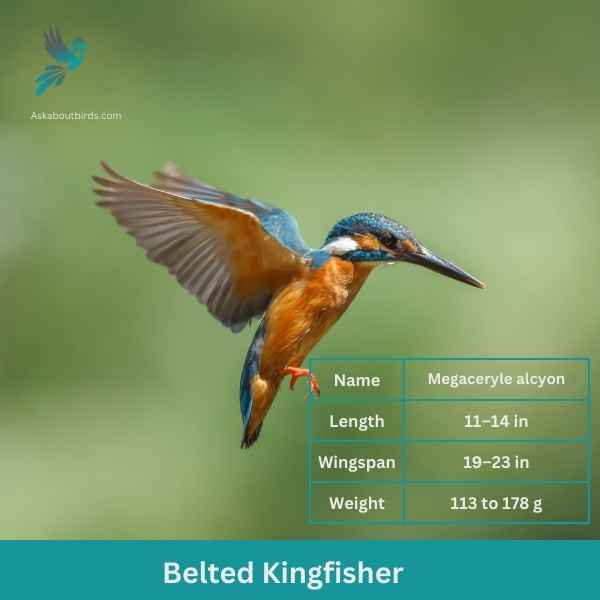
| Feature | Measurement |
|---|---|
| Scientific Name | Megaceryle alcyon |
| Length | 11–14 in |
| Wingspan | 19–23 in |
| Weight | 113 to 178 g |
The Belted Kingfisher is a distinctive and easily recognizable bird, frequently observed near water bodies, where it can be seen diving headfirst to catch prey.
Appearance: Sporting a prominent crest, the Belted Kingfisher has a slate blue-gray upper body and white underparts. Males possess a single blue band across their white chests, while females have an additional rufous band, making them one of the few bird species where females are more brightly colored than males. Their bill is long, sharp, and dagger-like.
Diet: As expert fishers, Belted Kingfishers mainly prey on small fish, but they’ll also consume crustaceans, insects, and amphibians. They’re known for their hunting tactic of hovering over water, spotting their prey, and then diving swiftly to snatch it.
Reproduction: Belted Kingfishers nest in burrows which they excavate in sandy or earthen banks, usually adjacent to water. The tunnel can be anywhere from 3 to 6 feet long, ending in a chamber. Within this chamber, the female lays a clutch of 5 to 8 white eggs.
Barn Swallow


| Feature | Measurement |
|---|---|
| Scientific Name | Hirundo rustica |
| Length | 6.5–7.5 in |
| Wingspan | 12.5–13.5 in |
| Weight | 16–22 g |
The Barn Swallow is a sleek, agile bird renowned for its graceful flight patterns and iconic forked tail, often seen darting over fields and water bodies in search of flying insects.
Appearance: Barn Swallows have deep blue, almost iridescent, upperparts and a rufous to tawny underbelly. Their distinctively forked tail and long wings give them a streamlined look. Both males and females have a similar appearance, though males often exhibit slightly brighter colors and a deeper fork in the tail.
Diet: Barn Swallows feed primarily on flying insects, which they catch in mid-air during their agile and acrobatic flights. Their diet includes flies, beetles, moths, and other small flying insects.
Reproduction: Barn Swallows are known for building their mud nests on man-made structures, particularly barns, bridges, and eaves. The nest is cup-shaped and made from mud pellets, often lined with feathers. The female lays a clutch of 4 to 6 eggs.
Blue Grosbeak
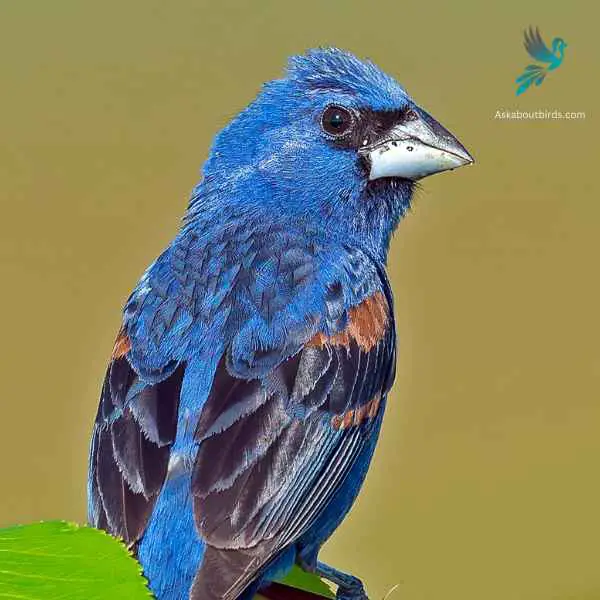

| Feature | Measurement |
|---|---|
| Scientific Name | Passerina caerulea |
| Length | 5.5 to 7.5 in |
| Wingspan | 10 to 11 in |
| Weight | 26 to 31.5 g |
The Blue Grosbeak is a medium-sized songbird found in North and Central America. The male Blue Grosbeak displays stunning plumage with deep blue feathers on its body and head, while the female has more subdued brownish tones. Both sexes have a thick, conical bill, which gives them their name “grosbeak,” meaning large beak.
These birds prefer open habitats such as grasslands, brushy areas, and woodland edges. Blue Grosbeaks are known for their melodious songs, which consist of a series of rich and varied notes. They primarily feed on seeds and insects, using their strong beaks to crack open seeds and forage on the ground or in low vegetation.
Blue-winged Warbler
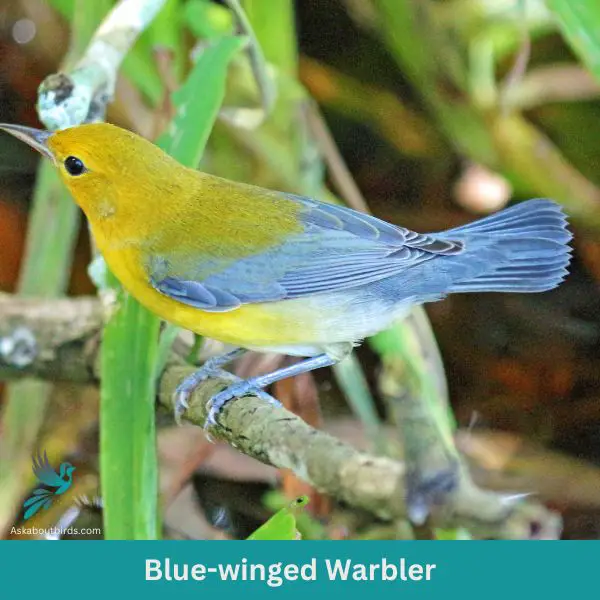
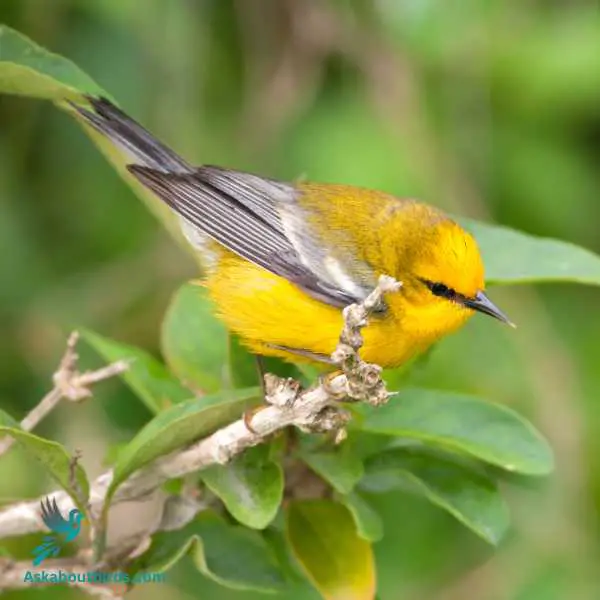
| Trait | Blue-winged Warbler |
|---|---|
| Scientific Name | Vermivora cyanoptera |
| Length | 4.3-4.7 inches |
| Wingspan | 6.7-7.5 inches |
| Weight | 0.3-0.4 ounces |
The Blue-winged Warbler is a vibrant songbird that stands out with its lemon-yellow coloring and buzzing song.
Appearance: This warbler displays a brilliant yellow body contrasted by blue-gray wings and a slim, black line through the eyes. The wings also feature two white wing bars.
Diet: The diet of the Blue-winged Warbler primarily consists of insects and spiders. They actively forage in shrubs and low trees, picking off their prey from the foliage.
Reproduction: Blue-winged Warblers build their nests on or near the ground, using grasses and other fine materials. The female lays a clutch of 4-6 eggs, which she incubates.
Cerulean Warbler
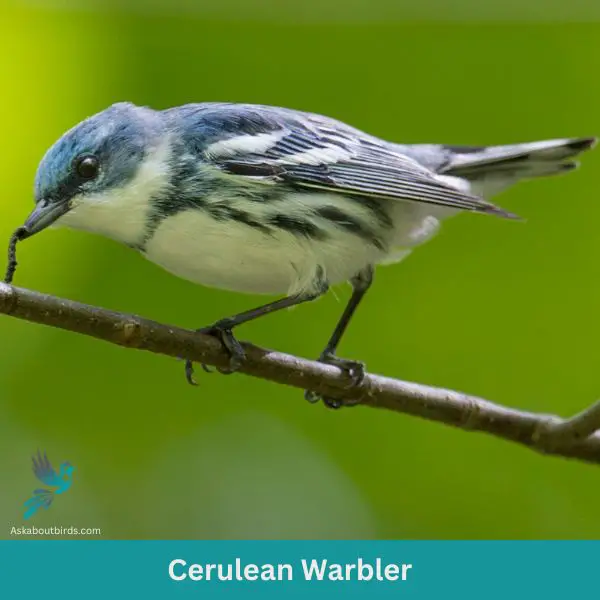
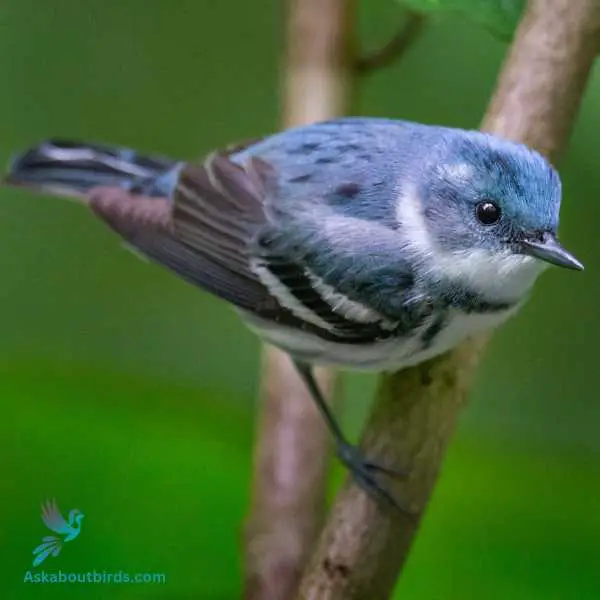
| Trait | Cerulean Warbler |
|---|---|
| Scientific Name | Setophaga cerulea |
| Length | 4.5 inches |
| Wingspan | 7.9-8.7 inches |
| Weight | 0.3-0.4 ounces |
The Cerulean Warbler is a striking songbird known for its sky-blue plumage and flitting movements in the forest canopy.
Appearance: Males boast a vibrant cerulean blue color on their upperparts, with streaked underparts, and a black necklace. Females have a more subdued bluish-green hue and lack the prominent black markings seen in males.
Diet: The diet of the Cerulean Warbler is predominantly made up of insects and spiders. They actively forage high in the treetops, gracefully maneuvering through leaves and branches.
Reproduction: Cerulean Warblers nest in the upper branches of tall deciduous trees. The female weaves a shallow cup-shaped nest and lays a clutch of 3-5 eggs.
Where to Spot Virginia’s Blue Birds
From the Atlantic coastline to the majestic Blue Ridge Mountains, Virginia offers birdwatchers unparalleled opportunities to observe a wide range of avian species. Here are the top 3-5 locations known for their extraordinary bird diversity:
- Shenandoah National Park: Located in the Blue Ridge Mountains, this national park provides a perfect habitat for a diverse set of birds, including several species of blue birds. Skyline Drive offers numerous overlooks for birding.
- Chincoteague National Wildlife Refuge: Situated on the Eastern Shore, this refuge is a haven for waterfowl and shorebirds. Migratory birds frequently use this area as a stopping point, offering a wide variety of species to observe.
- Great Dismal Swamp National Wildlife Refuge: This extensive swamp and forest habitat in southeastern Virginia is home to a broad spectrum of bird species, including the Prothonotary Warbler and other water-associated birds.
- Back Bay National Wildlife Refuge: Located in Virginia Beach, this coastal refuge is an excellent spot for observing migratory birds as well as various waterfowl and shorebirds.
- James River Park: In the heart of Richmond, this urban park along the James River attracts a surprisingly diverse array of birds, including a variety of blue birds, making it an easy and accessible birding location.
| Neighboring State’s Blue Birds | Best Spots to See a Wide Range of Blue Birds |
|---|---|
| Kentucky’s Blue Birds | 1. Daniel Boone National Forest 2. Mammoth Cave National Park 3. Bernheim Forest |
| Maryland’s Blue Birds | 1. Assateague Island National Seashore 2. Catoctin Mountain Park 3. Blackwater National Wildlife Refuge |
| North Carolina’s Blue Birds | 1. Great Smoky Mountains National Park 2. Nantahala National Forest 3. Cape Hatteras National Seashore |
| Tennessee’s Blue Birds | 1. Great Smoky Mountains National Park 2. Big South Fork National River and Recreation Area 3. Radnor Lake State Park |
| West Virginia’s Blue Birds | 1. Canaan Valley National Wildlife Refuge 2. New River Gorge National Park and Preserve 3. Coopers Rock State Forest |
FAQs on Blue Bird Species Found in Virginia
What can I do to attract bluebirds to my backyard?
To attract bluebirds to your backyard, consider setting up bird feeders filled with sunflower seeds, as these blue beauties, particularly the male indigo buntings, visit bird feeders and are particularly fond of sunflower seeds. Also, installing nest boxes or birdhouses around your property can encourage breeding birds to take up residence. Bluebirds, being secondary cavity nesters, prefer tree cavities or nest boxes for breeding. Furthermore, planting scattered trees and tall trees in your backyard can also provide suitable perching and nesting spots. Another way to attract bluebirds is to have a birdbath as they enjoy clean water for drinking and bathing. Lastly, maintaining a natural habitat with deciduous forests and promoting bluebird conservation efforts in your community will create a more inviting environment for these blue colored birds.
Do bluebirds stay in Virginia year-round?
Yes, some species of bluebirds, especially the Eastern Bluebird, can be found in Virginia year-round. While they primarily feed on insects, they will visit bird feeders during the winter months when insects are scarce. To promote bluebirds’ stay during winter, it’s important to provide food such as sunflower seeds and mealworms in your bird feeders. Additionally, providing roosting boxes can give them a place to stay warm. Lastly, keeping water sources from freezing and maintaining natural habitats like deciduous forests and tree cavities are essential in supporting bluebirds during the winter months.


